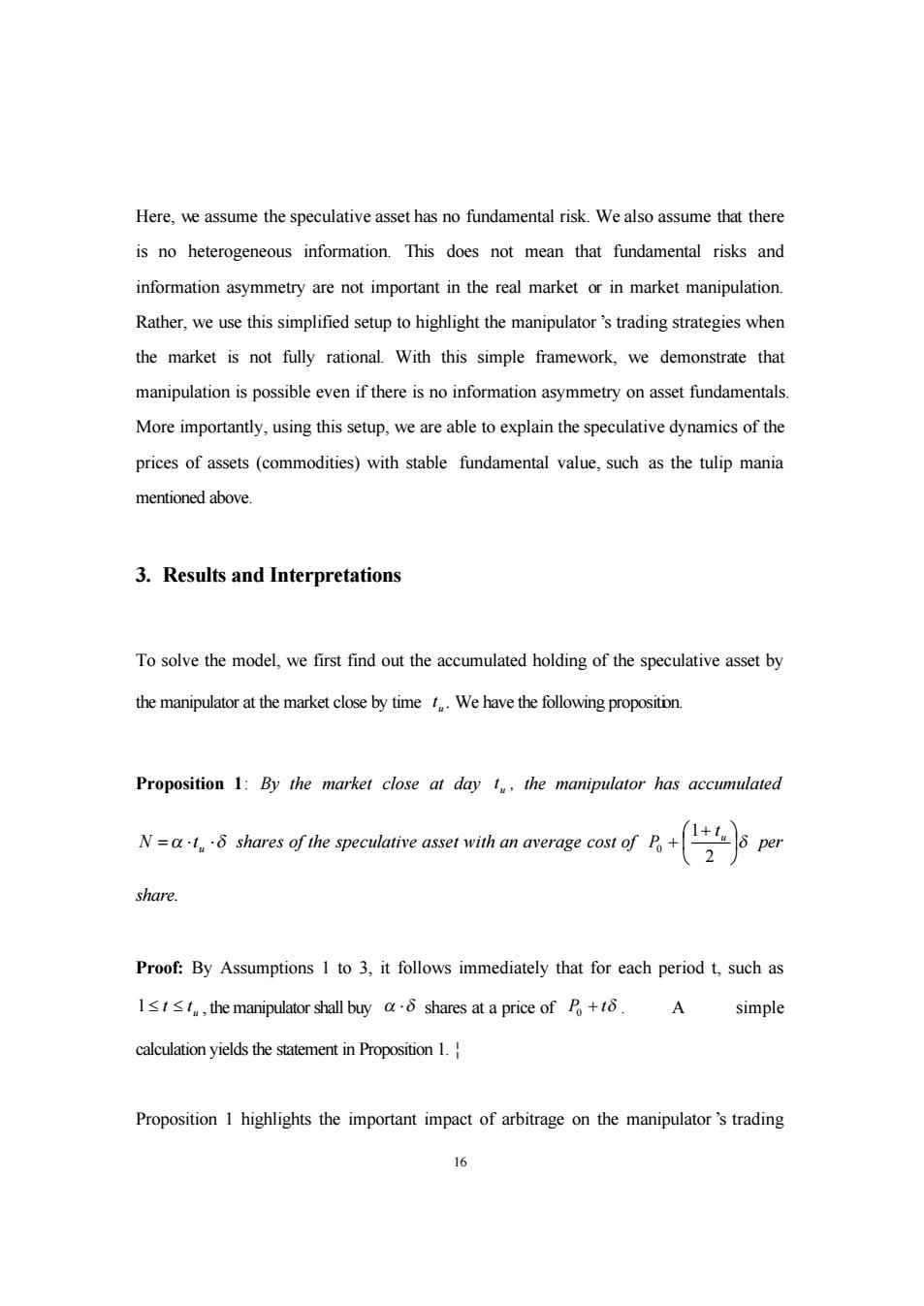
The manipulator tends to move the asset price up by a fixed amount of 6>0 for t (t>1)consecutive periods from day I to day t.That is P-P-=δ>0,t=1,2,…,tm. 2) By the close of day t the manipulator has accumulated certain number of shares of the speculative asset.He starts liquidating his shares from day t+I and keeps doing so until he has sold all of his shares by time T-I for some T>t+1.We define t=T-1-t as the length of time the manipulator takes to liquidate his shares accumulated by time t In order to ensure market equilibrium for each day,d shall satisfy certain condition as discussed subsequently.Assumption 4 is not the only possible assumption that can make manipulation profitable,but is a simple one. Assumption 5.The manipulator leaves the market right after he has sold all his shares at T-1.The market ends at time T and by then investors receive a liquidating dividend of P for each share of the speculative asset. Assumption 5 is not really needed for discussing the manipulation issue in the model.We make this assumption here following the convention in the literature and the widespread belief that in the long run,fundamental rules.The assumption is useful in discussing certain asset price anomalies such as long-term reversal.It is easy to see from assumptions 3 and 5 that the net purchases of arbitrageurs are zero over the whole time periods. 15
15 The manipulator tends to move the asset price up by a fixed amount of d > 0 for u t ( > 1 u t ) consecutive periods from day 1 to day u t . That is 0, 1,2, , . t t 1 u P - P = > t = L t - d (2) By the close of day u t , the manipulator has accumulated certain number of shares of the speculative asset. He starts liquidating his shares from day u t +1 and keeps doing so until he has sold all of his shares by time T-1 for some > +1 u T t . We define d u t = T -1 - t as the length of time the manipulator takes to liquidate his shares accumulated by time u t . In order to ensure market equilibrium for each day, d shall satisfy certain condition as discussed subsequently. Assumption 4 is not the only possible assumption that can make manipulation profitable, but is a simple one. Assumption 5. The manipulator leaves the market right after he has sold all his shares at T-1. The market ends at time T and by then investors receive a liquidating dividend of P0 for each share of the speculative asset. Assumption 5 is not really needed for discussing the manipulation issue in the model. We make this assumption here following the convention in the literature and the widespread belief that in the long run, fundamental rules. The assumption is useful in discussing certain asset price anomalies such as long-term reversal. It is easy to see from assumptions 3 and 5 that the net purchases of arbitrageurs are zero over the whole time periods

Here,we assume the speculative asset has no fundamental risk.We also assume that there is no heterogeneous information.This does not mean that fundamental risks and information asymmetry are not important in the real market or in market manipulation. Rather,we use this simplified setup to highlight the manipulator's trading strategies when the market is not fully rational.With this simple framework,we demonstrate that manipulation is possible even if there is no information asymmetry on asset fundamentals. More importantly,using this setup,we are able to explain the speculative dynamics of the prices of assets (commodities)with stable fundamental value,such as the tulip mania mentioned above. 3.Results and Interpretations To solve the model,we first find out the accumulated holding of the speculative asset by the manipulator at the market close by time t.We have the following proposition. Proposition 1:By the market close at day t,the manipulator has accumulated N=at.6 shares of the speculative asset with an average cost of Po- 2 per share. Proof:By Assumptions 1 to 3,it follows immediately that for each period t,such as l≤t≤t.,the manipulator shall buy·δshares at a price of P+td.A simple calculation yields the statement in Proposition 1. Proposition I highlights the important impact of arbitrage on the manipulator's trading 16
16 Here, we assume the speculative asset has no fundamental risk. We also assume that there is no heterogeneous information. This does not mean that fundamental risks and information asymmetry are not important in the real market or in market manipulation. Rather, we use this simplified setup to highlight the manipulator ’s trading strategies when the market is not fully rational. With this simple framework, we demonstrate that manipulation is possible even if there is no information asymmetry on asset fundamentals. More importantly, using this setup, we are able to explain the speculative dynamics of the prices of assets (commodities) with stable fundamental value, such as the tulip mania mentioned above. 3. Results and Interpretations To solve the model, we first find out the accumulated holding of the speculative asset by the manipulator at the market close by time u t . We have the following proposition. Proposition 1: By the market close at day u t , the manipulator has accumulated =a × ×d u N t shares of the speculative asset with an average cost of ÷d ø ö ç è æ + + 2 1 0 u t P per share. Proof: By Assumptions 1 to 3, it follows immediately that for each period t, such as u 1 £ t £ t , the manipulator shall buy a ×d shares at a price of P + td 0 . A simple calculation yields the statement in Proposition 1. ¦ Proposition 1 highlights the important impact of arbitrage on the manipulator ’s trading